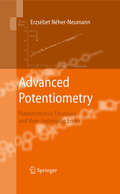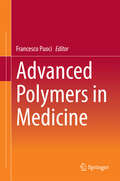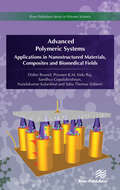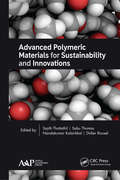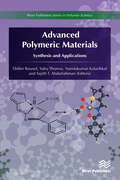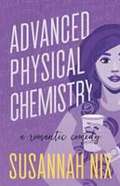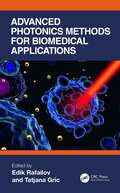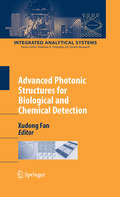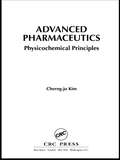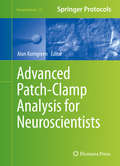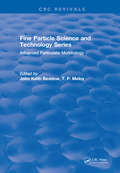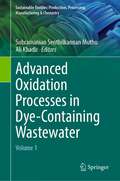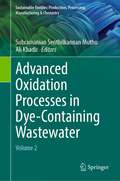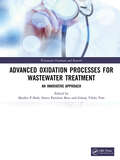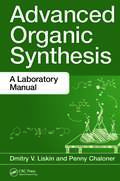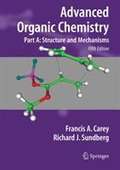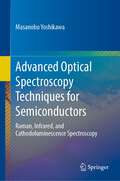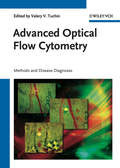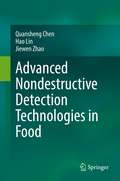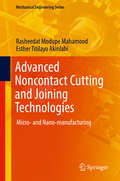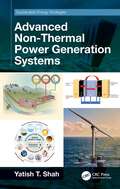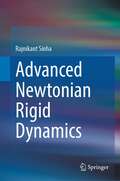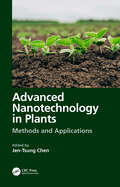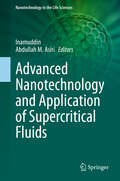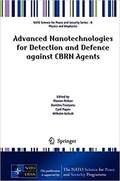- Table View
- List View
Advanced Potentiometry: Potentiometric Titrations and Their Systematic Errors
by Erzsébet Néher-Neumann"Advanced Potentiometry" details the accurate calculation of potentiometric titrations. Additional terms such as the ideal diffusion potential together with the contribution of activity factors furnish calculated stability constants which do not include systematic errors and thus present a complete and correct description of equilibrium processes. Moreover, serious systematic errors resulting from the recent use of curve-fitting computer programs are highlighted later in the text. "Advanced Potentiometry" can advantageously be used by lecturers, researchers, PhD graduates and undergraduate students working in the fields of Solution Chemistry, Physical Chemistry, Inorganic Chemistry and Analytical Chemistry and Environmental Research.
Advanced Polymers in Medicine
by Francesco PuociThe book provides an up-to-date overview of the diverse medical applications of advanced polymers. The book opens by presenting important background information on polymer chemistry and physicochemical characterization of polymers. This serves as essential scientific support for the subsequent chapters, each of which is devoted to the applications of polymers in a particular medical specialty. The coverage is broad, encompassing orthopedics, ophthalmology, tissue engineering, surgery, dentistry, oncology, drug delivery, nephrology, wound dressing and healing, and cardiology. The development of polymers that enhance the biocompatibility of blood-contacting medical devices and the incorporation of polymers within biosensors are also addressed. This book is an excellent guide to the recent advances in polymeric biomaterials and bridges the gap between the research literature and standard textbooks on the applications of polymers in medicine.
Advanced Polymeric Systems: Applications in nanostructured materials, composites and biomedical fields (River Publishers Series In Polymer Science Is A Series Of Comprehensive Academic And Professional Books Which Focus On Theory And Applications Of Polymer Science. Polymer Science, Or Macromolecular Science, Is A Subfield Of Materials Science Concerned With Polymers, Primarily Synthetic Polymers Such As Plastics And Elastomers. The Field Of Polymer Science Includes Researchers In Multiple Disciplin)
by Didier Rouxel K. M. Praveen Indu Raj Sandhya Gopalakrishnan Nandakumar Kalarikkal Sabu ThomasOver recent years a considerable amount of effort has been devoted, both in industry and academia, towards the incorporation of various macro, micro and nano sized fillers into polymers. There is also much interest in the evaluation of various polymer properties with respect to a wide set of applications. The advances in nanotechnology together with the development in material sciences has improved the shortcomings of these materials over the decade. This book covers the latest advances in the field of polymer nanocomposites and polymer composites for varied applications. The major topics discussed in the book include: • Nanostructured materials for energy applications • Nanostructured polymercomposites • Bio-polymers • Nanostructured polymers for biomedical applicationsThe book contains extended and updated research papers that were initially selected for the ICAMP-2017 conference which focused on advances in polymer materials.The book is ideal for researchers and practitioners in polymer science and materials science as well as for graduate students in polymer chemistry, materials science, nanotechnology and biomedical engineering.
Advanced Polymeric Materials for Sustainability and Innovations
by Sabu Thomas Sajith Thottathil Nandakumar Kalarikkal Didier RouxelThis informative volume discusses recent advancements in the research and development in synthesis, characterization, processing, morphology, structure, and properties of advanced polymeric materials. With contributions from leading international researchers and professors in academic, government and industrial institutions, Advanced Polymeric Materials for Sustainability and Innovations has a special focus on eco-friendly polymers, polymer composites, nanocomposites, and blends and materials for traditional and renewable energy. In this book the relationship between processing-morphology-property applications of polymeric materials is well established. Recent advances in the synthesis of new functional monomers has shown strong potential in generating better property polymers from renewable resources. Fundamental advances in the field of nanocomposite blends and nanostructured polymeric materials in automotive, civil, biomedical and packaging/coating applications are the highlights of this book.
Advanced Polymeric Materials: Synthesis, Properties, And Advanced Applications
by Didier Rouxel Sabu Thomas Nandakumar Kalarikkal Sajith T. AbdulrahmanRecent advances in polymer research has led to the generation of high quality materials for various applications in day to day life. The synthesis of new functional monomers has shown strong potential in generating novel polymer materials, with improved properties.Advanced Polymeric Materials includes fundamentals and numerous examples of polymer blend preparation and characterizations. Developments in blends, polymer nanocomposites and its various characterization techniques are highlighted in the book.
Advanced Physical Chemistry: A Romantic Comedy
by Susannah Nix<p>After four lousy boyfriends in a row, chemical engineer Penny Popplestone swears off men until she can figure out why they keep cheating on her. But her no-men resolution hits a snag when the mysterious and superhumanly hot barista at her favorite coffee shop strikes up a friendship with her. <p>Penny strives to keep things platonic, but when Caleb gives her the kiss of her life, she realizes he wants to be more than just friends. Tired of always being "good little Penny," she throws caution to the wind and pursues a no-strings fling with the hottie barista. It's not like they have anything in common beyond scorching physical chemistry, so what does she have to lose? <p>Only her heart. <p>Now, this fanfic-reading, plus-size heroine faces an unsolvable problem. What do you do when being apart is unbearable...but being together is impossible? <p>Advanced Physical Chemistry is the third in a series of standalone rom-coms featuring geeky heroines who work in STEM fields.</p>
Advanced Photonics Methods for Biomedical Applications
by Edik Rafailov Tatjana GricAdvanced photonics methods for biomedical applications give researchers in universities and industries, and clinicians an overview of the novel tools for cancer diagnostics and treatment. This book provides researchers and professionals in the area of biomedical photonics with a toolbox of novel methodologies for biomedical applications, including health diagnostics, cancer detection, and treatment. It covers the theory, modeling, and design of each method, alongside their applications, fabrication, characterization, and measurements in clinical practice. A wide scope of concepts concerning innovative science and technologies of medicine will be covered, providing the readers with the latest research, developments, and technologies. It will also be a valuable resource for students and early-career researchers, alongside those involved in the design of the novel photonics-based techniques for health diagnostics and cancer detection and treatment. Key features • Discusses novel methods of cancer diagnostics and cancer treatment. • Details non and minimally invasive photonics techniques. • Explores the applications of machine learning and artificial intelligence to these novel techniques.
Advanced Photonic Structures for Biological and Chemical Detection (Integrated Analytical Systems)
by Xudong FanThis book is a part of Books Series on Integrated Microanalytical Systems. It discusses the latest applications of photonic technologies in bio-chemical sensing. Based on the photonic structures, the book is divided into four sections: Photonic crystal structures; Optical microring resonator structures; Optical fiber/waveguide structures; and, Miscellaneous or hybrid structures.
Advanced Pharmaceutics: Physicochemical Principles
by Cherng-ju KimDiscussing a comprehensive range of topics, Advanced Pharmaceutics: Physicochemical Principles reviews all aspects of physical pharmacy. The book explains the basic, mechanistic, and quantitative interpretation skills needed to solve physical pharmacy related problems. The author supplies a strong fundamental background and extensively covers therm
Advanced Patch-Clamp Analysis for Neuroscientists (Neuromethods #113)
by Alon KorngreenThis volume presents current adaptations of the patch-clamp technique to neuroscience. Chapters focus on in-vivo recordings, voltage-gated channel recording and analysis, dendritic and axonal recordings, synaptic current recording and analysis, advanced fluorescent techniques, optogenetics and voltage-sensitive dye imaging, and finally channel and neuronal modeling. Written for the popular Neuromethods series, chapters include the kind of detail and key implementation advice that ensures successful results in the laboratory. Authoritative and practical, Advanced Patch-Clamp Analysis for Neuroscientists aims to ensure successful results in the further study of this vital field.
Advanced Particulate Morphology
by John Keith BeddowThis volume, based on the 1977 NSF Residential Advanced Particle Morphology Workshop, covers the principle developments in this new and rapidly evolving field. The divergent fields of interst of the authors reflect the prosepcts for the wide application of particle morphology analysis and include: many branches of science and engineering concerned with fine particles, information processing, life sciences, pharmacy, and food technology.
Advanced Oxidation Processes in Dye-Containing Wastewater: Volume 1 (Sustainable Textiles: Production, Processing, Manufacturing & Chemistry)
by Subramanian Senthilkannan Muthu Ali KhadirAmong various industries releasing wastewater into the environment, printing, dyeing and textile industries are of great importance as they frequently contain high amounts of colorful compounds having high chemical and biological oxygen demands. Health related effects of colorants are extensively reported; which necessitates the seriousness of dye removal from water and wastewater. The utilization of advanced oxidation processes (AOPs) in dye degradation has gained considerable attention recently due to the release of high energetic radicals as oxidants that are capable of removing dye compounds. This Volume 1 presents versatile applications of AOPs in dye removal. Accordingly, processes such as Ozone-based AOPs, UV irradiation, catalytic AOPs, etc are discussed with the aim of dye removal under different operational parameters. The role of different nanoparticles is also investigated. By presenting the fundamentals of AOPs as well as recent advances, this book is useful for environmental engineers and chemists who are concerned with wastewater pollution and treatment.
Advanced Oxidation Processes in Dye-Containing Wastewater: Volume 2 (Sustainable Textiles: Production, Processing, Manufacturing & Chemistry)
by Subramanian Senthilkannan Muthu Ali KhadirTextile industry wastewater contains toxic dyes as well as heavy metals and many other persistent organic compounds which are difficult to biodegrade using conventional biological methods. Advanced Oxidation Processes (AOPs) are one of the best alternatives for the effective degradation of such compounds. This Volume 2 starts with homogeneous and heterogeneous Fenton processes and reviews the application and variables that affect the process. It then discusses plasma technology- an emerging method in terms of its chemistry, treatment set-up, limitations, etc. The positive performance of carbon tetrachloride in process intensification of dye degradation is presented. The other chapters include topics such as sonoenzymatic treatment processes, electroflocculation versus textile wastewater, combination of photocatalysis and membrane Separation, and enhancement of anaerobic digestion and photodegradation through adsorption.
Advanced Oxidation Processes for Wastewater Treatment: An Innovative Approach (Wastewater Treatment and Research)
by Maulin P. Shah Sweta Parimita Bera Günay Yıldız TöreAdvanced Oxidation Processes for Wastewater Treatment: An Innovative Approach: This book highlights the importance of various innovative advanced oxidation technology to clean up the environment from pollution caused by human activities. It assesses the potential application of several existing bioremediation techniques and introduces new emerging technologies. This book is an updated vision of the existing advanced oxidation strategies with their limitations and challenges and their potential application to remove environmental pollutants. It also introduces the new trends and advances in environmental bioremediation technology with thorough discussion of recent developments in this field. This book highlights the importance of different innovative advanced oxidation process to deal with the ever-increasing number of environmental pollutants. Features: Illustrates the importance of various advance oxidation processes in effluent treatment plant Points out the reuse of the treated wastewater through emerging advance oxidation technologies for effluent treatment plant Highlights the recovery of resources from wastewater Pays attention to the occurrence of novel micro-pollutants Emphasizes the role of nanotechnology in bioremediation of pollutants Introduces new trends in environmental bioremediation
Advanced Organic Synthesis: A Laboratory Manual
by Dmitry V. Liskin Penny ChalonerLaboratory experience equips students with techniques that are necessary for professional practice. Advanced Organic Synthesis: A Laboratory Manual focuses on a mechanistic background of key reactions in organic chemistry, gives insight into well-established trends, and introduces new developments in the field.The book features experiments performe
Advanced Organic Chemistry
by Francis A. Carey Richard J. SundbergSince its original appearance in 1977, Advanced Organic Chemistry has maintained its place as the premier textbook in the field, offering broad coverage of the structure, reactivity and synthesis of organic compounds. As in the earlier editions, the text contains extensive references to both the primary and review literature and provides examples of data and reactions that illustrate and document the generalizations. While the text assumes completion of an introductory course in organic chemistry, it reviews the fundamental concepts for each topic that is discussed. <p><p> The two-part fifth edition has been substantially revised and reorganized for greater clarity. Among the changes: Updated material reflecting advances in the field since 2001’s Fourth Edition, especially in computational chemistry; A companion Web site provides digital models for study of structure, reaction and selectivity; Solutions to the exercises provided to instructors online. <p> The material in Part A is organized on the basis of fundamental structural topics such as structure, stereochemistry, conformation and aromaticity and basic mechanistic types, including nucleophilic substitution, addition reactions, carbonyl chemistry, aromatic substitution and free radical reactions. Together with Part B: Reaction and Synthesis, the two volumes are intended to provide the advanced undergraduate or beginning graduate student in chemistry with a sufficient foundation to comprehend and use the research literature in organic chemistry.
Advanced Optical Spectroscopy Techniques for Semiconductors: Raman, Infrared, and Cathodoluminescence Spectroscopy
by Masanobu YoshikawaThis book focuses on advanced optical spectroscopy techniques for the characterization of cutting-edge semiconductor materials. It covers a wide range of techniques such as Raman, infrared, photoluminescence, and cathodoluminescence (CL) spectroscopy, including an introduction to their physical fundamentals and best operating principles. Aimed at professionals working in the research and development of semiconductors and semiconductor materials, this book looks at a broad class of materials such as silicon and silicon dioxide, nano-diamond thin films, quantum dots, and gallium oxide. In addition to the spectroscopic techniques covered, this book features a chapter devoted to the use of a scanning electron transmission microscope as an excitation source for CL spectroscopy. Written by a practicing industry expert in the field, this book is an ideal source of reference and best-practices guide for physicists, as well as materials scientists and engineers involved in the area of spectroscopy of semiconductor materials. Further, this book introduces the cutting-edge spectroscopy such as optical photothermal IR and Raman spectroscopy or terahertz time-domain spectroscopy (THz-TDS) etc.
Advanced Optical Flow Cytometry: Methods and Disease Diagnoses
by Valery V. TuchinA detailed look at the latest research in non-invasive in vivo cytometry and its applications, with particular emphasis on novel biophotonic methods, disease diagnosis, and monitoring of disease treatment at single cell level in stationary and flow conditions. This book thus covers the spectrum ranging from fundamental interactions between light, cells, vascular tissue, and cell labeling particles, to strategies and opportunities for preclinical and clinical research. General topics include light scattering by cells, fast video microscopy, polarization, laser-scanning, fluorescence, Raman, multi-photon, photothermal, and photoacoustic methods for cellular diagnostics and monitoring of disease treatment in living organisms. Also presented are discussions of advanced methods and techniques of classical flow cytometry.
Advanced Nondestructive Detection Technologies in Food
by Quansheng Chen Hao Lin Jiewen ZhaoThis book comprehensively introduces non-destructive methods for food quality (i.e. external, internal, sensory, components, and microbiological indicators) detection, through optics, acoustics, chemistry, imaging, and bionic sensing. It highlights in-situ detection of food quality and safety, including principles, signal processing, and analysis of data, non-destructive detection system, and application in the food industry for each method. First, this book introduces the principles and characteristics of various food non-destructive methods. As non-destructive measurements always involve obtaining big data for each testing, this book also describes in detail the signal and big data processing for each non-destructive method. The chapters also introduce the rapid portable detection equipment for food and agricultural products developed in recent years, as well as the intelligent monitoring equipment in the process of food processing. Relevant application cases are provided to help readers better understanding how to apply non-destructive technology for food quality detection. In the noninvasive measurement of food quality, this book has a systematic introduction of the detection principle, data processing, and rapid detection system, in-field detection case studies. This book is novel and practical and can be used as a professional textbook for undergraduates majoring in food science and engineering. It can also be used as a reference book for scientific research and technical personnel engaged in the field of food quality and safety detection.
Advanced Noncontact Cutting and Joining Technologies: Micro- And Nano-manufacturing (Mechanical Engineering)
by Rasheedat Modupe Mahamood Esther Titilayo AkinlabiThis book illuminates advanced cutting and joining processes, what they are used for, and the capabilities of these manufacturing techniques, especially in micro- and nano-fabrication. The authors illustrate the use of water jets and lasers that can be used to cut highly complex shapes without leaving burrs of heat affected zones, as well as friction stir welding processes that were not possible in the past. Rounding out their examination, the authors describe in detail the use of additive manufacturing for fabrication of micro and nano-scale components and the direction of future research. Incorporating many examples from industry, the book is ideal for professional engineers, technicians, and fabrication managers in multiple industries.
Advanced Non-Thermal Power Generation Systems (Sustainable Energy Strategies)
by Yatish T. ShahGenerally, sources for power generation are broken down into two categories: thermal and non-thermal. Thermal sources for power generation include combustion, geothermal, solar, nuclear, and waste heat, which essentially provide heat as a means for power generation. This book examines non-thermal (mechanical, electrochemical, nanoscale self-powered, and hybrid) sources of power generation and emphasizes recent advances in distributed power generation systems. Key Features Details recent advances made in wind power, including onshore, offshore, fixed and floating platform, and air wind energy systems, and offers detailed assessments of progress Covers advances in generation of hydropower, exploring dam hydropower, novel wave energy converters, and novel systems and turbines for hydrokinetic energy conversion to power Examines all types of fuel cells and their multi-functional roles, along with hybrid fuel cell systems in complete detail Explores advances in the development of self-powered nanogenerators for use in portable, wearable, and implantable power electronics Focuses on technologies with the best commercial possibilities and provides perspectives on future challenges that need to be solved This book will be of value to all researchers in academia, industry, and government interested in pursuing power generation technologies and seeking a comprehensive understanding of available and emerging non-thermal power generation sources. Readers who are interested in learning about thermal power generation sources can find it in the author’s companion text Advanced Power Generation Systems: Thermal Sources (2023).
Advanced Newtonian Rigid Dynamics
by Rajnikant SinhaThis book discusses topics on D’Alembert’s principle, virtual work, Eulerian angles, Lagrange’s equation in generalized coordinates and motion of a top. Momental ellipsoid of a point of a rigid body and conservation principle of angular momentum are discussed in detail. This is an essential textbook on Newtonian rigid dynamics, useful for advanced undergraduate and graduate students of physics, mathematics and engineering. This book contains solutions to more than 350 examples as well as more than 350 figures, which are nicely explaining the concept of rigid dynamics. Necessary mathematics have been created at the spot where they are needed.
Advanced Nanotechnology in Plants: Methods and Applications
by Jen-Tsung ChenNanotechnology uses nanomaterials/nanoparticles that can penetrate plant cells and interact with intracellular organelles and metabolites impacting plant growth, development, physiology, and biochemistry. Advanced Nanotechnology in Plants: Methods and Applications explores emerging plant nanotechnology, covering advanced methods and applications with an emphasis on the mitigation of plant diseases and environmental stressors. This technology can lead to the improvement of crop quality and yield to face the challenge of global climate change with an expanding global population.Features: Summarizes advanced methods and current applications of nanotechnology to mitigate plant stress Supports the Paris Agreement, which tackles three main objectives for sustainably increasing agricultural productivity and incomes, adapting and building resilience to climate change, and reducing and/or removing greenhouse gas emissions Discusses potential uses and future directions in green nanotechnology for smart and sustainable agriculture The content fits the goals of the UN SDGs contributing to goals 12 and 15 for responsible consumption and production and sustainable use of terrestrial ecosystems Provides current research findings of engineered nanoparticles for phytoremediation This book is a reference for students, researchers, and scientists in the field of plant sciences and nanotechnology. It is also useful for those in green chemistry, and environmental sciences, and can be a practical handbook for academics, including teachers, students, and agricultural experts.
Advanced Nanotechnology and Application of Supercritical Fluids (Nanotechnology in the Life Sciences)
by Inamuddin Abdullah M. AsiriGlobalization and industrialization involve a number of reactions, products, extractions, and separations that require the use of organic solvents. These solvents are responsible for a number of ecological concerns, including atmospheric and land toxicity. Conventional organic solvents are regarded as volatile organic compounds; some are even limited due to their potential for ozone layer depletion. While supercritical liquids exhibit physical properties that could make them ideal substitutes for these volatile compounds, there is particular interest in the use of carbon dioxide as a solvent of crude material. In particular, carbon dioxide has apparent ‘green’ properties, like its noncombustible nature, the fact that it is generally nonpoisonous, and its relative inertness. Thus, the use of supercritical carbon dioxide can provide practical improvements to the sustainability of industrial products and processes. This book provides in-depth literature in the area of industrial green processes, focusing on the separation, purification, and extraction of compounds utilizing supercritical carbon dioxide as a green solvent.
Advanced Nanotechnologies for Detection and Defence against CBRN Agents (NATO Science For Peace And Security Series B: Physics and Biophysics)
by Wilhelm Kulisch Cyril Popov Plamen Petkov Dumitru TsiulyanuProvides an up-to-date overview on various nanostructured materials and nanotechnologies for different security and safety related areas. <P><P>The content spans synthesis, characterization and diverse applications of nanoscaled materials.<P> Includes contributions from physicists, chemists, material scientists, engineers and biologists.<P>This volume gives a broad overview of advanced technologies for detection and defence against chemical, biological, radiological and nuclear (CBRN) agents. It provides chapters addressing the preparation and characterization of different nanoscale materials (metals, oxides, glasses, polymers, carbon-based, etc.) and their applications in fields related to security and safety. In addition, it presents an interdisciplinary approach as the contributors come from different areas of research, such as physics, chemistry, engineering, materials science and biology. A major feature of the book is the combination of longer chapters introducing the basic knowledge on a certain topic, and shorter contributions highlighting specific applications in different security areas.
